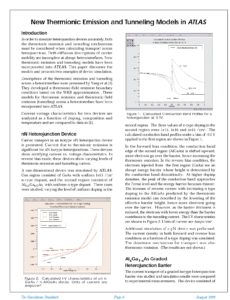New Thermionic Emission and Tunneling Models in ATLAS
In order to simulate heterojunction devices accurately, both the thermionic emission and tunneling mechanisms must be considered when calculating transport across hetrojunctions. Drift-diffusion descriptions of carrier mobility are incomplete at abrupt heterointerfaces. New thermionic emission and tunneling models have been incorporated into ATLAS. This paper discusses the models and presents two examples of device simulation.
Descriptions of the thermionic emission and tunneling across a heterointerface were presented by Yang et al.[1] They developed a thermionic-field emission boundary condition based on the WKB approximation. These models for thermionic emission and thermionic-field emission (tunneling) across a heterointerface have been incorporated into ATLAS.
Current-voltage characteristics for two devices are analyzed as a function of doping, composition and temperature and are compared to data in [1].
nN Heterojunction Device
Carrier transport in an isotype nN heterojuction device is presented. Current due to thermionic emission is significant for nN isotype heterojunctions. These devices show rectifying current vs. voltage characteristics. In reverse bias mode, these devices show varying levels of thermionic emission and tunneling current.
A one-dimensional device was simulated by ATLAS. One region consisted of GaAs with uniform 1e15 /cm3 n-type dopant, and the second region consisted of Al0.25Ga0.75A0.75As, with uniform n-type dopant. Three cases were studied, varying the level of uniform doping in the second region. The three values of n-type doping in the second region were 1e15, 1e16 and 5e16 /cm3. The calculated conduction band profiles under a bias of -0.1 V applied to the first region are shown in Figure 1.



